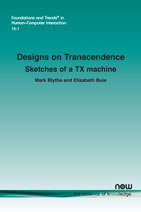Designs on Transcendence: Sketches of a TX machine
By Mark Blythe, Northumbria University, UK, mark.blythe@northumbria.ac.uk | Elizabeth Buie, Nexer Digital Ltd, UK, eabuie@gmail.com
Abstract
Despite the vast number of people who use technology as a part of their spiritual practice, there is little research on the subject in studies of Human–Computer Interaction (HCI). Although HCI takes the idea of user experience very seriously, the field gives almost no consideration to experiences with technology that might be described as spiritual or transcendent. This paper reviews the work that HCI has produced in this area, but also draws on related research in psychology, philosophy, sociology, anthropology, digital religion, psychopharmacology, and neuroscience. The literature indicates that transcendent experiences can be facilitated physically (through natural environments, architecture, art, music), chemically (with psychedelic compounds such as psilocybin, LSD, ketamine, and mescaline), and also digitally (in virtual reality, meditation apps, and research prototypes). While there are a wide range of perspectives within the literature, many terms recur describing transcendence as: ineffable, intense, ephemeral, paradoxical and sometimes sacred; mystical transcendent experiences are characterized by unity, epiphany, and an altered perception of time and space; common emotional responses include ecstasy, tranquility, gratitude, awe, and reverence. Such experiences are similar across religious and cultural backgrounds but interpretations vary according to world view. Studies record benefits of transcendent experiences such as substance use recovery and improved mental health. We explore the themes in the literature through an illustrated design fiction depicting a near-future conference on transcendent experience (TX) research. This is an extended and illustrated speculation around brain–computer interfaces that might evoke transcendent experiences. The article ends with a manifesto calling for a radically interdisciplinary field that would bridge cultural divides and move beyond models of health and wellbeing to establish new forums and venues for TX research.
Designs on Transcendence: Sketches of a TX machine
Despite the vast number of people who use technology as a part of their spiritual and transcendental practice, there is little research on the subject of digital transcendence in studies of Human Computer Interaction (HCI). This monograph reviews the work that HCI has produced in this area but also draws on related research in psychology, philosophy, sociology, anthropology, digital religion, psychopharmacology, and neuroscience. While there are a wide range of perspectives within the literature, transcendent experiences (TXs) are similar across religious and cultural backgrounds but interpretations vary according to world view. Recurring terms describing these experiences are: ineffable, intense, ephemeral, paradoxical, sacred, unity, epiphany, altered perception of time and space, ecstasy, tranquility, gratitude, awe, and reverence. Studies also record benefits of TXs such as substance use recovery and improved mental health.
Transcendence and spirituality are deeply subjective experiences and there are many aspects of this topic that academic writing cannot easily approach. For this reason, the authors have combined a traditional academic review with design fiction. They explore the themes in the literature through an illustrated design fiction depicting a near future conference on TX research. This is an extended and illustrated speculation around brain computer interfaces that might evoke TXs. The monograph ends with a manifesto calling for a radically interdisciplinary field that would bridge cultural divides and move beyond models of health and wellbeing to establish new forums and venues for TX research.
